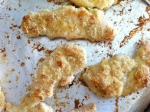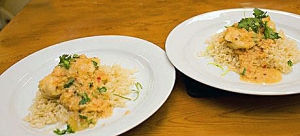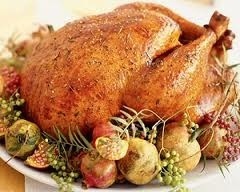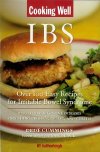Based on my experience with having an autoimmune disease, I have created the following list. Think of it as a kind of spring cleaning. Remember everyone is different, so some of my tips may not work as well for you but it’s worth a try (and as most of my readers know, I recommend keeping a daily log of your diet and activities and stress level). Here are “Dede’s daily tips” as follows:
- You should eliminate all sugar from your diet.
- They say no alcohol or coffee, but maybe a tiny bit of black tea, or half a cup of coffee with boiling water a day. I also have one or two drinks over the weekend. Vodka tonic or gin and tonic; sometimes I have a light beer.
- No dairy. That said, I do allow myself 1 tablespoon of half-and-half in my tea or coffee per day. That’s my only luxury!
- No grains at all! Focus on big salads (with avocado and organic vegetables and a hard boiled egg in the mix—make your own dressing with pure olive oil and a little bit of lemon juice or balsamic vinegar)), and chicken, fish and eggs (all organic and the fish should be cold water/wild caught), and chopped nuts and dried fruit.
- Start drinking green, organic Moroccan mint tea in the afternoon for a little pick me up, and snack on carrots and hummus. At night, always drink a cup of chamomile tea with a little honey. This will help you de-stress your body. And mind.
- Try to get out and exercise, usually walking (or slow jog), 3 miles per day. When you come back, do gentle Rodney Yee yoga for about 20 minutes, and then do guided meditation for about 1 to 5 minutes. When you do guided meditation try to focus on healing and forgiveness and bring the breath from the top of the head down the spina. Focus on the breath. I always do a cleansing mantra that goes like this: white light healing inflammation gone.
- Try to get at least seven hours of sleep a night
- Take a hot bath or shower and use lavender in the bath before you go to bed. Try to read a book before you go to bed to take your mind off social media, etc.
- Get acupuncture once a month. Get a massage once a month (I know this is expensive, but it’s worth it!)
- Take a really good quality probiotic every night before bed. I usually take the Jarrow brand with the highest count of lactobacillus and acidophilus.
- Take omega-3, a multivitamin, vitamin C, hi high-potency turmeric/curcumin, and some liquid vitamin D drops every day.
- When you feel a tiny bit of a scratchy throat or rundown, add an immune booster homeopathic liquid (usually it’s about 30 drops in water) once a day before going to bed. Note: when I’m really feeling sick, with actual symptoms like cough or fever, I take goldenseal and echinacea in liquid drops.
- Carry a small spray canister of Bach Flower Remedy in your knapsack or purse. When you really feel rundown or stressed, just spray twice in your mouth. It really helps!
- As far as this list goes just try it for three months and see if it helps, then continue for three years (!). But really do it carefully! You can make things using almond flour and coconut flour (homemade tortillas, yum—black beans are okay in moderation and I mix them with roasted veggies/roasted potatoes).
- I forgot to mention that I love coconut milk—unsweetened—that you can use for breakfast. I usually mix bananas and nuts with dried fruit and cut up melon or strawberries in a bowl and add coconut milk to make a kind of morning cereal.
- Drink tons of water every day as well! I think that’s it… but I hope it helps.
Try to plan some kind of trip, and remember, it doesn’t have to be expensive or involve air travel which can add to the stress. Just a trip to the beach or a hike with a friend or loved one is a great way to relax. Going out in the woods every day is amazing.
👣🌱👣🌱👣
Happy Spring! I would love it if readers shared their own tips in the comment area.
Blessings,
Dede
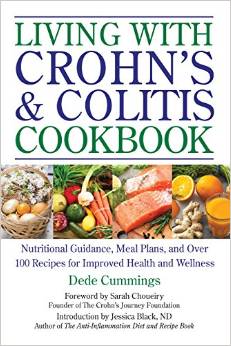 Our new cookbook is out and Dede would like to give away a free copy to the first two people who comment on this post — tell us a bit about yourself, are you a caregiver, do you have Crohn’s, or colitis, or IBS, or some other autoimmune disease? When you receive your book (send email in PM to dede@livingwithcrohnsandcolitisbook.com), please post a review on Amazon for us and we will be eternally grateful!
Our new cookbook is out and Dede would like to give away a free copy to the first two people who comment on this post — tell us a bit about yourself, are you a caregiver, do you have Crohn’s, or colitis, or IBS, or some other autoimmune disease? When you receive your book (send email in PM to dede@livingwithcrohnsandcolitisbook.com), please post a review on Amazon for us and we will be eternally grateful!
We are excited to share these gut-friendly recipes from the book and there is a long introduction about how to live with IBD and tips to help.
For the millions of people afflicted with irritable bowel disease (IBD), including Crohn’s and colitis, it can be a daily struggle to find nutritious meals that won’t aggravate symptoms or cause a flare-up. The Living with Crohn’s & Colitis Cookbook is your essential nutrition guide with over 100 recipes and meal plans expertly designed to improve daily functioning and help relieve symptoms of Crohn’s and colitis.
The Living with Crohn’s & Colitis Cookbook contains everything you need to plan your meals, balance your diet, and manage your symptoms, including:
• A guide to keeping a food journal
• Sample meal plans
• Tips for shopping for an IBD diet
• Gentle and nutritious recipes to help soothe flare-ups
…and much more!
The Living with Crohn’s & Colitis Cookbook features over 100 recipes, including Zucchini Buckwheat Banana Bread, Homemade Almond Milk, Dr. Lang’s Healing Soup, Garlic-Herbed Scallops, Coconut Curry Chicken over Brown Rice, Mushroom Risotto with Cashews and Parmesan, Crabapple Walnut Cake, and many more. The book also features Paleo recipes.
Enjoy these photos from our book!
In some human diseases, the wrong mix of bacteria seems to be the trouble.
I recently discovered a new blog that is specifically for Chronic Fatigue Syndrome and Fibromyalgia. It is called Health Rising and the link is below.
There are articles that explore gut health and microbiota by Ken Lassesen, that really explain the importance on overall homeostasis for everyone, whether you have Crohn’s, colitis, IBS, IBD, Celiac, etc.
I am on a strict diet of no dairy, no grains, no sugar. Supplements include probiotics and turmeric. I am really healthy and haven’t had symptoms for almost eight years! I did have a partial bowel resection, in 2006, that changed my life and set me on a path toward wellness— that is when I wrote my book because I was disillusioned by the recommendations of my GI doctors who said I should take heavy-duty, autoimmune-suppressing drugs.
Read more: Bacterial Resistance, Infection and Chronic Fatigue Syndrome: Fighting Infections Pt. I http://www.cortjohnson.org/blog/2014/03/26/bacterial-resistance-infection-chronic-fatigue-syndrome-fighting-infections-pt-1/
~~~
~
In some human diseases, the wrong mix of bacteria seems to be the trouble, Part 2.
A recent NPR story on gut bacteria and Crohn’s disease really impressed me, so I want to share it in its entirety here on my blog!
Mix Of Gut Microbes May Play Role In Crohn’s Disease
The particular assortment of microbes in the digestive system may be an important factor in the inflammatory bowel condition known as Crohn’s disease.
Research involving more than 1,500 patients found that people with Crohn’s disease had less diverse populations of gut microbes.
“[This] basically for the first time identifies what might be the bacterial changes in patients with Crohn’s disease,” says Ramnik Xavier, of Masssachusetts General Hospital in Boston, who led the work.
More than a million Americans suffer from Crohn’s, which seems to start when an overreactive immune system causes abdominal pain, diarrhea, bleeding, weight loss and other symptoms. Many patients have to take powerful steroids (which can have serious side-effects), and some have parts of the digestive tract surgically removed.
Mounting evidence has suggested that microbes living in the gut might contribute to the problem. So Xavier and his colleagues compared the species of bacteria in more than 447 Crohn’s patients to the mix of microbes in more than 221 healthy people.
In their paper published in the journal Cell, Host and Microbe, the researchers detailed the clear difference they discovered: The patients with Crohn’s seemed to have too many of the sorts of bacteria that rile immune systems.
In addition to having less diversity in their gut microbes, Xavier says, the Crohn’s patients had fewer bacteria that have been associated with reduced inflammation and more bacteria associated with increased inflammation. (The findings were confirmed in 800 Crohn’s patients from other studies.)
Interestingly, children whose doctors had tried to treat their Crohn’s symptoms with antibiotics before they were properly diagnosed had a mix of microbes that was the most out of whack.
“We may have to revisit the use of antibiotics in [these] patients with early-onset Crohn’s disease,” Xavier says.
Instead, doctors might eventually do better to identify and prescribe treatments that mimic the helpful bacteria, he says, along with foods or other pharmaceutical agents that reduce or counteract the harmful bacteria.
“There’s the possibility that we might be able to identify [some] sort of super-probiotics that might be able to correct the gut back to the healthy state,” Xavier says.
UCLA pathologist Jonathan Braun, who studies microbial ecology, says the paper offers important first insights into illnesses beyond Crohn’s. “Other diseases are thought to be driven at least in part by bacteria,” he says, such as some inflammatory and autoimmune disorders. Bacteria may also be involved in obesity.
Humans should work harder to understand bacteria, Braun says, “and live with them when they’re helping us, or get them to serve us better when they are causing harm.”
~
Good for the media to pick up in the importance of balance in the flora and fauna of the gut—remember, everyone is different and there is no know cure for Crohn’s (for UC, the large colon can be removed, putting the patient in remission, but that is not the case for Crohn’s unfortunately).
So, with Spring on the way, now is the time to set some goals for health: sign up for Team Challenge with the Crohn’s and Colitis Foundation of America, walk 3 miles a day (get your heart rate up by walking up hills), do yoga/meditate, get lots of sleep, make an appointment with a naturopath, too. Spring brings with it hope for new life (and here in Vermont, lots of mud!).
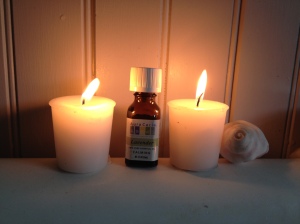 It is our hope that our readers have benefitted from the New Year, 3-month, Plan for Wellness. Here are seven painless and simple at-home acupuncture steps you can do to maintain good health and vitality. I recommend acupuncture and we had a wonderful guest blog post a few months ago that a lot of our readers thanked us for.
It is our hope that our readers have benefitted from the New Year, 3-month, Plan for Wellness. Here are seven painless and simple at-home acupuncture steps you can do to maintain good health and vitality. I recommend acupuncture and we had a wonderful guest blog post a few months ago that a lot of our readers thanked us for.
My naturopath also has me on a total “detox” regimen that includes castor oil packs, meditation (I use Rodney Yee’s “AM Yoga” DVD, or try Jon Kabat-Zinn’s wonderful collection of relaxation CDs), skin “sloughing” before shower (which entails roughing up your skin with a loofah sponge from your extremities toward your heart and encourages new cell growth), drinking plenty of water, regular exercise and daily yoga, counseling with a social worker or psychotherapist, weekly (free) REIKI and monthly massage visits, acupuncture sessions monthly, and physical therapy with integrative manual therapy-healing. A good attitude also helps. I regularly repeat to myself positive messages like:
“Don’t let this disease rule your life and get you down, but when you need to, ‘Ask for Help!’”
This simple YouTube mindfulness video by Jon Kabat-Zinn is wonderful, and Dr. Kabat-Zinn was one of the first to bring mindfulness into medicine!
The suggestions I receive from my naturopath are an attempt to enhance my body’s natural elimination processes through the digestive system, kidneys, skin, liver, and lungs. All are essential to help me optimize elimination with minimal aggravation while also undergoing specific treatment suggestions with my gastroenterologist. I have found this support team and naturopathic/acupuncture treatment to be extremely effective as an aid that can dramatically lessen the physical effects of inflammatory bowel disease.
These seven relaxation techniques are really easy to do at home. I do them before my shower daily! Foot massages are also very beneficial, which I do before bed with some moisturizer (I add a bit of organic apricot or sesame oil to the Pure Essentials moisturizer to thicken it up, and I also put cotton socks over my feet if calluses are bad), as well as candle-lit hot baths with lavender oil drops in the water.
- Brush your gums and tongue. Spend at least 5 minutes each time you brush (longer is even better). Set a timer because 5 minutes may seem like a very long time at first. The acupuncture points along the gums match with the entire body system, as does the tongue.
- Brush your scalp. Remember when moms insisted that we always brush our hair for 50 strokes? Turns out, there are hundreds of acupuncture points on the scalp itself. For a quick session, massage the governing vessel 20. This point is located at the very top of the head, the point of 100 meeting points, which enables you to access several channels at once. Spend time massaging your scalp with your fingernails and even while you shampoo.
- Push back your cuticles on your fingers and toes. Just the act of pushing back your cuticles stimulates acupuncture points that go directly to every muscle and tendon in the body, bringing on relaxation. Need to keep a small child quiet at an event? This works like a charm. Plus you can trace every finger front and back as well.
- Loofah your body. This is a hard sponge that softens with use. Loofah plants can be grown, and are much softer than those found at most department stores. (Note: when purchasing a loofah, be sure it says ‘loofah’ on the package.) Use the loofah wherever there is skin. There are thousands of acupuncture points all over the body. If you find a sore or itchy spot, spend extra time there. It is likely that it is an acupuncture point that needs stimulation. Electricity is accumulating there and stimulation via massaging or using a loofah disperses this accumulation. Before showering, use the loofah sponge to aggressively rub from the extremities toward the head, beginning with the arms, then working up from the feet. After you rub all the dead cells off your body, an invigorating shower further energizes you and allows for the stimulation of new cell growth.
- Moisten your nasal membranes. When you splash water on your face, keep water on your little fingers. Put your little fingers inside your nose and moisten all around. You do not need to sniff water up into your sinuses. Moistening your nasal membranes increases your chi (your body’s bio-electrical energy).
- Breathing exercises. Most of us are chest breathers, rather than abdominal breathers, so we tend to breathe shallow most of the day. On inspiration (breathing in), push your stomach out as far as you can. On expiration (breathing out), let your stomach fall back to neutral. This is very difficult to do at first without thinking about it. When you breathe with your abdomen it forces the diaphragm to drop and thus increases your lung capacity. This is why singers practice breathing so that they are able to sustain notes much longer. Breathing leads to more oxygen, more chi and more energy.
- Massage your face, hands, feet, and ears. You can do this yourself, but it is more relaxing and fun if done by someone else. These areas also treat the entire body individually.
(Grateful to Patricia S. Wesley, D.C. for her support)
Daily massage and stimulation will increase blood flow, help improve the effectiveness of your current therapies, improve mood, decrease inflammation, and promote healing.
Remember to think positive, and here is a wonderful quote and photo from the XIV Dalai Lama.
We like to hear from our readers, and thanks for helping spread the word about our book and recommendations!
—Dede, a Crohn’s disease/ulcerative colitis patient perspective—post surgical removal of ileum, large segment of Sigmoid colon, and fistula/granuloma mass—symptom-free for the past eight years, but still a Crohnie/uc-er by definition…
Happy Holidays from Dede & Jessica at Living With Crohn’s & Colitis!
This plan was developed as a guide for generating a treatment regimen. Just as each individual is unique, so too is their road to wellness. This 3-month plan is meant to be used loosely, so you should feel free to adjust each step as needed for your own recovery. Please consult your physician when beginning this program, and continue to visit your established team of specialists (naturopath, gastroenterologist, etc.) so that they can help you monitor your progress and make any necessary adjustments to the program.
As discussed in our book—and is a good idea to read the book before beginning this plan—treatments and lifestyle changes can occur in any order, but here we have provided a plan that will slowly and gently move you through your digestive problems and into wellness. Most patients will feel some positive changes as they progress through this 3-month plan and some patients may even become symptom-free.
The most important aspect of this step-by-step process for building health is that we are creating a foundation for wellness and building upon it, rather than trying to overwhelm the body by incorporating all changes at once. Taking new strides each week helps to keep you focused and motivated through the entire process. We know that change can be overwhelming, which is why we’ve created this program so that it can also be slowed down even further to incorporate new changes every 3 weeks and can be specifically tailored to your individual needs.
NOTE: All severe conditions and the need for surgery must be ruled out by your physician prior to starting this program. If initial acute symptoms are severe, they must be treated either with natural medicine or pharmaceutical medicines to provide relief while working on the underlying imbalances.
NOTE: Stress is a precursor to disease and flare-ups. If you are a parent of a child with IBD, or a patient or caregiver, try to help keep the holidays as stress-free as possible! (Easy for me to write this, as I woke up at 3:00 a.m. worrying about buying presents …. and planning a party! Yikes. But I am off to walk 4 miles this morning AND DO YOGA AND MEDITATE!!!
Weeks 1–2:
1. See the change and believe in the change! Visualize optimal colon health daily. See yourself happy, active, and vibrant in your mind.
2. Proper Mealtime Habits—eat slowly, and take your time preparing, shopping, and don’t overeat, or try new foods during the holidays!
3. Remove major dietary causes of inflammation—keep a food journal, and stay away from trigger foods!
4. Add only one supplement or herbal medicine, whichever best suits you. This may be an acute remedy for diarrhea, acidophilus, or any other supportive medicine—for example. I just bought a new supplement—turmeric—because I ran out.
5. Herbal teas: pick one of the teas that best fit your needs and drink daily. I choose Perppermint! Also Chamomile is a good stress reducer. Add honey for sweetening (NO SUGAR AT ALL!)
Weeks 3–4:
1. Continue previous points.
2. Add an additional supplement or herbal medicine—talk to your doctor or naturopath about Vitamin D, or Omega 3.
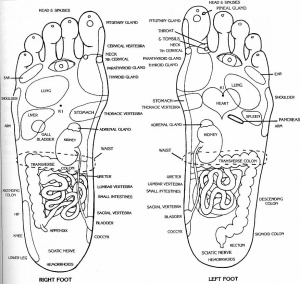 3. Begin the Tapping for Energy technique (in our book) or daily acupressure. Dede likes to massage her feet before bed, using a nice mix of moisturizer and sesame or apricot oil. It is amazing how much stress in in our feet and the acupressure points relate to organs in the body. It is a great routine to press gently on some of these points — the chart shows you were the bowel area is (also liver point is important to gently press).
3. Begin the Tapping for Energy technique (in our book) or daily acupressure. Dede likes to massage her feet before bed, using a nice mix of moisturizer and sesame or apricot oil. It is amazing how much stress in in our feet and the acupressure points relate to organs in the body. It is a great routine to press gently on some of these points — the chart shows you were the bowel area is (also liver point is important to gently press).
4. Experiment with adding more anti-inflammatory foods and spices into your diet. Last night, I made a fish curry with garnishes of bananas, raisins, chopped apples . . . yum!
Message me if you want the recipe. It was mild, not too spicy, and used Haddock filet.
Weeks 5–6:
1. Continue previous points.
2. Add an additional supplement or herbal medicine. I take grape seed extract when I feel a cold or flu coming on. Try a warm bath at night with lavender oil.
3. Begin to incorporate movement/exercise. Do this at least 3 times per week, but daily possible. This is VERY important…start slowly, but try every day. Begin with your mind—just change the way you think about exercise (like when you get busy at work or with life, don’t eliminate it!).
Weeks 7–8:
1. Continue previous points.
2. Incorporate daily nutritional powders into your diet such as spirulina, kelp, green tea, or acai powder—try these sparingly at first, and make sure nothing irritates (Dede does not use spiraling, but kelp and green tea really help keep inflammation at bay. An excellent overall nutritional supplement, but use the best brand and tell your doctor. Here is a nice article from Dr. Oz on acai powder. Dede has acupuncture once a month-another great thing to introduce—if it is too expense, find a “community-supported acupuncture” place to go, like a clinic. Dede’s acupuncturist gives her a discount ($55 per 1 hour session!) because she has a sliding scale. Acupuncture really helps!
3. Add an additional supplement, if needed. PROBIOTICS ARE GREAT, according to Dede, who takes 1/4 teaspoon of powder every day. Again, buy from Naturopath, or Metagenics is a good company. Dede uses “Synergy” brand, all flora.
Weeks 9–10:
1. Continue previous points.
2. Add an additional supplement if needed. Talk to your doctor about your magnesium/calcium levels—Dede takes a mag-citrate because she doesn’t have dairy in her diet. Plus, if you have been on steroids for treatment, you want to be sure your bone health/density is good, so it would be wise to talk to your doctor about having a test.
3. Incorporate mental and emotional support. This may be needed sooner in some individuals suffering from anxiety and depression contributing to their illness. Dede swears by “Talk Therapy,” and goes 2x a month. She tells her therapist everything about dealing with her disease, work, relationships, boundaries, stress, etc. THE BEST!
Weeks 11–12:
1. Continue previous points.
2. Add an additional supplement if still needing more support. Talk to your naturopath. Your electrolytes need to be balanced. Dede makes homemade chicken soup broth 2x a month. Dede loves being on a Paleo-like diet! NO SUGAR, NO GRAIN (can use Almond and Coconut flours), NO DAIRY!! This is the best! Use Almond mile, eat eggs and organic animal proteins (local chicken is good, beef—but make sure it is antibiotic-free and free range)
3. Incorporate colon hydrotherapy (castor oil packs 5 days per week or constitutional hydrotherapy treatments — details are in our book, along with tons of other lifestyle information! Dede loves her castor oil pack-when her abdomen is sore, she lies down with the pack and a heating pad, and reads, or meditates, or sleeps. Pain goes away!.
HAPPY HOLIDAYS!
Enjoy a stress-free New Years, and look forward to 2014! Remember, a positive attitude improves disease outcome, so “THINK POSITIVE!”
Since it is almost Thanksgiving, I thought I would write a post to wish everyone a happy, stress-free holiday, and try to help those with IBS, Crohn’s, and UC who may need some encouragement and advice.
We all know holidays can bring on the stress-inducing behaviors and hormones that cause internal signals to flare up in the body. When I was at the Mayo Clinic a few (short) months ago, I learned so much about controlling stress—make stress-reducing activities a priority, starting today, and leading up through the holiday season.
Your lifestyle structure is even more important here: daily exercise, gentle yoga, meditation, sleep, etc. Schedule appointments with professionals to help you lessen stress in your life: a talk therapist, acupuncture, massage (gift cards are good holiday presents for those you love!), etc. Do what makes you feel good about yourself AND relax! (I went to the salon yesterday for hair color!)
Tryptophan is one of the 10 essential amino acids that the body uses to synthesize the proteins it needs. It’s well-known for its role in the production of nervous system messengers, especially those related to relaxation, restfulness, and sleep.
I am now aware why I love turkey so much—I sometimes even crave it. I always feel more relaxed after I eat turkey, and this may explain why….There are many researchers who study the way tryptophan manufactures serotonin, a neurotransmitter that is found—guess where?—in the intestinal tract. Just about 90% of the body’s serotonin is actually found in the gut, so my gut tells me to eat it, and I am not even a biochemist!
Tryptophan has the ability to raise serotonin levels, too! Wow, who knew this? I love the fact that I can eat turkey and sample other holiday foods like nuts, seeds, bananas, pumpkins, squash, sweet potatoes, green beans with almonds, pearl onions (those sweet little ones, not the canned and creamed kind!) WITHOUT having a flare up. Also (again, who knew?!), Tryptophan also boosts the production of B3, and since I had a partial bowel resection in 2006, I need to keep track of my B vitamins (especially since my terminal ileum is completely gone, I have lost the capacity to fully absorb vitamin B12).
Everything I eat is sourced, and mostly bought from local farms. It is not that hard to do. For instance, our turkey is a Vermont-raised, free running turkey, and I picked it up yesterday from our local food coop. Potatoes are from here, also butternut squash, apples, pumpkins—are all from Vermont; cranberries are organic and from Cape Cod. I will be baking apples, too—delicious and easy. Some of us cannot eat nuts or cranberries, so avoid, but there is plenty to choose from!
Here are some tips: drink water before your meal to fill you up so you don’t overeat, take small portions, walk after the meal. If you have an ostomy, take extra supplies and a change of clothes to your hosts’ party. If you avoid sugar and alcohol, you will be less likely to flare up; also don’t try ANY food that is not on your list (remember the food journal from the book!).
On Wednesday/tomorrow, I will make some pies to drop off at our local Thanksgiving Day dinner for those less fortunate in our area—Don’t forget to do something to help someone else in need this week, and after. With all the holidays upon us, plan some special time each week to volunteer (soup kitchen, helping those who have been in a house fire, helping veterans, etc.). Thanksgiving was set as the fourth Thursday in November. This year, something amazing and historic has happened: After sundown on the second of Hanukkah’s eight days, we will also celebrate Thanksgiving. If you are Jewish, there is an even busier holiday!
I will post some recipes on my Facebook page! Be well, and breathe … A bit of dietary research unravels mysteries of cravings from this writer with uc/Crohn’s disease….Happy Thanksgiving & holidays everyone!











